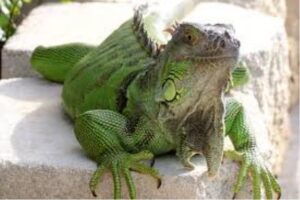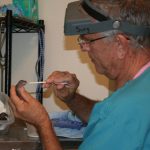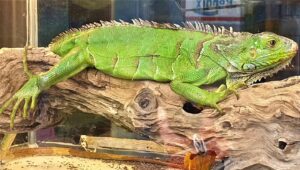
![]()

Caring for Your Green Iguana
Ron Hines DVM PhD
Green Iguanas come from the forests of Central and South America. Because they like warmth and sunshine, they live in the trees at the edge of the jungle and in clearings. Iguanas are active in the day-time and sleep at night.
There, they can be seen sunning themselves on large tree branches or feeding among the tree leaves. Iguanas are very territorial. A single large male guards a territory not much bigger than a residential lot and it will run off any other adult males that are in sight. I watched this, growing up near Tampico, Mexico.
 Is There More Than One Kind Of Iguana?
Is There More Than One Kind Of Iguana?
Yes, but there are not that many that look or act similar to your green iguana. There is the one you are considering or already have which is the common green iguana. There is a similar one that lives in on some Caribbean islands. (ask me for Priesmeyer2006). There are spiny tail iguanas native to Tamaulipas MX a few other isolated tropical climes and occasionally seen where I grew up in Brownsville, TX (perhaps escapees). There are rhinoceros iguanas, rock iguanas and a two types that live on the Galapagos Islands (see here). But the only one you are likely to see legally for sale or escaped in the USA are common green iguana – even though many of them are not that green.
 Why Do I See Iguanas In So Many Colors?
Why Do I See Iguanas In So Many Colors?
Healthy, baby iguanas should be an iridescent green:
As they mature, they tend to develop more shades of brown and cream. Their eye color also begins to vary. Iguanas have a remarkable ability to change their color to suit their moods and camouflage needs – so don’t be disappointed if the iguana sold to you as a “rare” color, changes back to a more common shade. What the iguanas have been eating may also influence their color.
There is also a natural variation in the knobs, bumps and lumps that develop with time on their bodies.
Mature Iguana’s colors, as well as their behavior, also change dramatically when they are in breeding season. At that time, they tend to develop shades of rust and orange:
Iguanas also get duller in color when they are getting ready to shed (every 5-8 weeks in the summer):
Your iguana’s color is also influenced by the temperature at which you keep it. If it remains too cold, it will get darker.
 Are Iguanas Safe To Keep As Pets?
Are Iguanas Safe To Keep As Pets?
Iguanas look more ferocious than they really are. However, when they are large, and snappy, they can bite you hard. These bites, can be particularly dangerous when they are on your face 
Younger iguanas occasionally bite by mistake when you attempt to feed them. If they have not been handled sufficiently, they may bite to escape. Iguanas in mating condition also clamp onto their partner by biting their neck. But the worst bites are from animals protecting their turf from someone they perceive as a a challenger to their territory. If you have any doubt how an iguana is going to behave, catch it in a large beach towel. I have been bitten through the towel. Also, just like humans, the basic disposition of iguanas vary. Some have a gentler temperament than others and some just need a lot of hands-on time to mellow. Time on your lap, wrapped in a towel, mellows most iguanas. Iguanas, particularly males, can have Dr. Jekyll/Mr. Hyde phenomena . Gentle pets can become testy for no apparent cause and aggressive iguanas can suddenly become mellow. Do not attempt to discipline a misbehaving iguana. It will not work.
Some owners try to decide what incident might have upset their iguana. There are iguana experts who try to use classical human psychology to analyze why the pet did this or that. But iguanas do not see the World the way we do. Their moods and behaviors are much more rooted in their hormone levels and their daily and yearly natural rhythms that govern their lives.
 Will An Iguana Make A Good Pet For My Kids?
Will An Iguana Make A Good Pet For My Kids?
Not for a child under 12 – 15 Most 12 year olds are not sufficiently mature to take care of pets. If your child is an exception, have him/her spend time helping an experienced iguana owner clean up and care for an iguana before deciding to buy one. Iguanas grow up. So do kids. And as iguanas grow up, their needs increase and your child’s desires will change. It is normal for children to move on in their desires and aspirations. A long-lived pet like an iguana or other reptile that is in demand one day out of impulse, probably won’t be top of your childs desires relatively soon. Young iguanas are fragile and don’t hold up to frequent handling by children. There are exceptions. I am one. I started caring for iguanas when I was 9. Also, all reptiles can be a source of Salmonella something I mention farther along in this article. (and read here & here)
How Bright Are Iguanas?
That depends on how much you love them. Iguana have a tranquility and mellowness that some people equate with understanding. Because they naturally live on plants, iguanas do not have to make as many decisions as reptiles that have to catch moving prey. But iguanas can solve simple problems and it is possible to teach them simple things. They are very much aware of what is going on around them.
 Where Should I Buy My Iguana?
Where Should I Buy My Iguana?
Before you buy one, check with iguana rescue sites online to see if one is available near you. Many owners buy iguanas on a whim, or their life circumstances change and they can no longer keep them. If you are new to iguanas, do not accept a rescue iguana that is aggressive or visibly ill. Do not take more than one iguana. Do not accept an iguana that has trouble walking or is noticeably deformed. Do not accept an iguana that will not eat. Many are offered or returned to pet stores when they become too large. Let stores in your area know that you would accept one.

 Purchase your iguana shortly after the shipment arrives when the selection is large and the animals have not sat around crowded and neglected. The lighting, temperature and diet in pet shops are usually wrong. The longer the iguanas live there, the weaker they will become.
Purchase your iguana shortly after the shipment arrives when the selection is large and the animals have not sat around crowded and neglected. The lighting, temperature and diet in pet shops are usually wrong. The longer the iguanas live there, the weaker they will become.
Never purchase from traveling vendors.
Insist on a written, 30-day replacement guarantee.
Purchase the most active, perky iguana in the group – do not purchase a sluggish, calm or “tame” one because they are tame because they are ill.
Purchase an iguana with the most vibrant green color.
Purchase in the early summer or fall.
Purchase only one.
Do not load up on all the accessories the clerk will try to sell you.
Despite what the salesperson tells you at the pet shop, these iguanas are rarely if ever “farm raised”. There value is just not great enough to justify the effort. They are more likely to have been plucked up by disadvantaged children in Central and South America, or hatched there from the eggs of trapped female iguanas.
 How Do I Tell A Boy Iguana From A Girl Iguana?
How Do I Tell A Boy Iguana From A Girl Iguana?
You cannot tell the sex of a baby iguana by looking at it. The iguana will have to be over a year and a half old (8-10 inches long) before males begin to look differently than females. Once they do begin to develop, male iguanas become more ornate and “flowery” than females. Their jaws becomes stouter and broader. Their heads become broader and they develop a dewlap or “jowls”. The round scale covering their eardrum becomes larger and more prominent than in females. Male iguanas also develop longer crests along the ridge of their spine and large pores on the inner surface of their thighs. They also become wider in the pelvic area.
Females remain sleek and look more like juveniles. In the photo below, the iguana to the left is a typical adult female , while the one on the right is a male.
 How Long Do Iguanas Live?
How Long Do Iguanas Live?
We do not know how long iguanas live in the wild. Captive iguanas often live to be 10-12 years old. There are reports of them having lived past 20 years in captivity. Only about a third of the iguanas sold in pet stores survive to maturity because of importation stress, improper diet, temperature and sunlight. In the wild, the number is even lower because the babies are finger-food for a number of jungle predators.
 What Kind Of Iguana Home Should I Purchase?
What Kind Of Iguana Home Should I Purchase?
For a baby iguana, up to 7″ long, a 55 gallon aquarium works fine. You will need to buy a “herp lid” which is a soft meshed cover to keep the pet in. You can pay many thousands of dollars for a high quality ,commercial iguana cage. But a high price does not guarantee a practical, well-designed cage. The larger the cage you provide for your iguana, the better. At a minimum, the width and depth of the enclosure should be 3 times the length of the iguana and the height should be 4 times the pet’s length. Iguanas are up-down, rather than left-right animals. If you have 8′ ceiling and a large iguana, make the cage wider. Iguanas do not like to be crowded. If you have more than one large iguana, increase the space accordingly.
I prefer to construct iguana cages myself. Three quarter inch, schedule 40 PVC pipe and fittings make an excellent frame. There is no need to glue the fitting. Leaving them unglued but give them a sold hammer tap so they stay in place. That allows for your later adjustments, expansion and redesign. I prefer covering the plastic pipe frame with black, vinyl-coated wire. The viny coating prevents them from injuring their nose. Fourteen gauge wire with one inch squares is fine. The gauge of vinyl coated wire is measured after the vinyl has been applied. Large iguanas cannot escape from 1″ x 2″ mesh. If you are housing immature iguanas, use 5/8th inch openings. A sharp pair of diagonal cutters will snip the wire mesh panels. Secure the mesh to the frame with plastic cable ties. keep the sharp, cut ends of the ties to the outside of the cage and cinch them tight with lineman’s pliers . You can also construct the cage from 12 gauge vinyl coated mesh using hog rings . If you do it that way, it is rigid enough without the plastic pipe frame.

As i mentioned, and want to warn you twice, iguanas do not do well in enclosures that are made out of uncoated wire. This is because they rub their nose on the metal mesh until they injure it, particulary if their cage is too small. Eventually, this distorts their face as in these photos:
Wood cage frames are not as desirable as cage frames constructed of pvc plastic pipe. Wood is hard to clean and sanitize. It also retains odors. If you must use wood, do not use pressure treated lumber. It is impregnated with chemicals. Use a non-resinous (e.g. white pine).You will find many free iguana cage plans on the internet. Wear gloves when you are cutting mesh, if you do not want to get punctures and blisters. Natural branch perches and logs work well. They should be at least the diameter of your pets open palms. Trim off small branches, sharp points and anything else that pokes or can be swallowed. You are always safest using branches and stumps of trees and bushes that are thornless and produce fruits and seeds that are naturally eaten by birds and other wildlife.
 How Large Will My Iguana Grow?
How Large Will My Iguana Grow?
If you have a male iguana, it can grow to over 5 feet long and weigh close to 9 pounds. Female iguanas won’t grow as large. They top out at about 4.3 feet long and 2.6 to 5.7 pounds. Not all individuals will reach that size. Iguanas just-out-of-the-egg are about 2.5-4.5 inches long. They grow rather slowly until they are eight or nine months old. After that, they grow much faster – if they are well cared for. By the time they are two years old, they can be 2-3 feet long. And by the time they are 3-4 yrs, they can be near their maximum size.
Is Keeping An Iguana A Lot Of Work?
Not much more than taking good care of a dog or cat. When it does become a big chore is when you purchased the pet for your child and eventually your child has loses interest in it or your home situation changes. Your chores will be different because the cage will need to be cleaned and maintained regularly. Doing some research before buying or building a cage is very important in designing one that is least troublesome to clean and maintain. The most time-consuming chore is maintaining proper temperature during the colder months of the year. Feeding an iguana correctly requires fresh produce. So you will have the added time and expense of frequent supermarket runs.
You will need to trim your iguana’s toenails regularly or take the pet to someone experienced in doing it.
 Is Your House Temperature Important?
Is Your House Temperature Important? 
Yes, it is very important. Next to food, proper temperature and sunlight are the most important keys to keeping your iguana healthy. Iguanas normally sunbathe to control their body temperature. If they are too cold, their immune system and their digestive system shut down. In northern climates, indoors and in confined spaces, your iguana can not do that (thermoregulate). So it will rely entirely on you to keep its body temperature correct. You can do this by constructing a temperature gradient within the iguana’s cage going from about 85F (29.4) at one end, to a basking area of 96F at the other. I tape several thermometers in the cage to keep track of the temperature. You can shut the lights off at night if the room temperature will not drop below 85F (29.4) . There are several ways to keep your iguana warm. “Hot rocks” or “sizzle stones” are not one of them ! Eventually, they will scald your pet. Forty-watt incandescent light bulbs, placed a few inches outside of the cage, work well. This allows the iguana to choose a location on his perch that best meets its heat and light needs. Heat lamps pointed into the cage are also OK – as long as the iguanas can avoid their heat when they want to and as long as they do not melt the vinyl mesh or start a fire. I do not like to hang heat sources inside the cages. They are too likely to be moved by the pets or cause skin burns. >
 What About A Source Of Water?
What About A Source Of Water?
The plants that your iguanas should be eating are about 80% water. That and tropical dew supplies all their water needs in the wild. If you are feeding a commercially prepared diet, they should have a source of additional water. I suggest that whatever you feed, you do keep a water dish in your iguana’s cage. A salad dish with a large rock in it will not over-turn. If humidity in the cage is too low, add several dishes. Change the water daily. Some iguanas enjoy licking drops of water off surfaces you mist in their cage.
 What About Lighting?
What About Lighting?
Read my article on Metabolic Bone Disease and Lighting here. Next to diet and temperature, providing the right kind of lighting is the most important thing you can do to keep your iguana healthy. Iguanas need the ultraviolet rays in full spectrum sunlight in order to manufacture vitamin D-3 . Without it, their bones will become weak. If your iguana’s cage is placed in an outside location where natural sunshine is abundant, it needs no extra source of ultraviolet light. If the sunshine passes through window glass, much of the important UVB rays will be lost. So purchasing a lamp that produces both UVA and UVB light is wise. Check the specifications of the lamps you purchase carefully. Not all full-spectrum bulbs perform well for lizards and many have a relatively short lifetime during which they deliver the full, rated light. Fluorescent lamps such as those by Reptisun™ are highly regarded. So are newer mercury vapor UV lamps that screw into ordinary light bulb sockets. Mercury vapor lamps have the added benefit of producing significant warmth. Either position these lamps outside of the cage or construct a wire mesh container to surround them so that the iguana can not burn itself.
Most reptile supplements contain vitamin D-3. However the poor response I see to supplemental vitamin D-3 injections in sick pet iguanas, makes me question whether iguanas can utilize supplemental vitamin D-3 in any form. It appears that they must manufacture it themselves in their skin in the presence of sunlight or appropriate artificial light sources.
 What About Humidity?
What About Humidity?
Iguanas need high humidity. They do best in locations that are positively muggy. If they do not get it, they suffer from difficult and incomplete sheds and a dull, scurfy appearance. Try to keep humidity in your iguana habitat at 65-75%. A chicken or laboratory hygrometer will help you keep track of the humidity but better ones designed for reptiles are available. Be sure the iguana can not eat the wick. Misting the pet and its cage frequently with a garden sprayer or plant spray bottle will help keep the humidity high. Be careful not to mist heat lamps or they will crack. Placing shallow vats or pans of water on the floor of the cage will also add humidity. Towels in the pans will help wick up and evaporate the water. When you run the AC, stuff old clothes into the AC vents in the iguana’s area because simply closing the duct grid is not sufficient. In dry climates, or forced-air heat, you may need to place a humidifier in the room. You can also add an outdoor submersible fountain pump and an aquarium heater to a decorative rock fall or garden fountain in the cage to increase humidity. The more the water drips and agitates, the more will evaporate. Just be sure all wiring is secured tight to the frame with cable ties and the the system is on a GFI receptacle.
 What Should I Feed My Iguana?
What Should I Feed My Iguana?
Iguanas and children are not good judges of what it is healthy to eat. Wild iguanas do not have this problem. They were designed to eat the lush jungle foliage that surrounds them. That is what their intestines were designed to digest. The plant materials they normally eat are not very nutritious as they are consumed. But bacteria and protozoa that live within the iguana’s intestines ferment the plant matter into all the nutrients that the iguana needs. They are similar to the ones that help cows digest grass. (read here) The leaves and flowers that iguanas naturally eat will not be available to you in most parts of the US or Europe. It’s just natural to want to feed pets things that we know are healthy for us humans. But iguanas are very different from us in their nutritional needs. The truth is , no one knows what iguana diet is best for a long and healthy life. What we do know are the kind of diets that are bad for iguana health. These are diets that are too rich in protein and carbohydrates.
 What about Just Feeding A Commercial Iguana Food From The Pet Store?
What about Just Feeding A Commercial Iguana Food From The Pet Store?
I do not recommend them. Despite the labels, not enough is known about iguana nutrition for any manufacturer to produce a scientifically proven food. Shelf-life issues, profitability, owner eye-appeal, unknown ingredient quality, bulk manufacturing processes and storage conditions all make commercially-prepared diets much less desirable than feeding fresh produce. Their only advantage is that they save you time and space. The same warning goes for cat food, dog food and monkey chow. Feed them to cats, dog and monkeys – not iguanas.
 What Are Some Foods That Are Good To Feed My Iguana?
What Are Some Foods That Are Good To Feed My Iguana?
Feed iguanas of all ages the same. Just cut the produce into smaller pieces for small iguanas. Feed a diet that is primarily or totally green leafy vegetables. some Iguanas remain healthy when they receive small amounts of sugary or starchy fruits and vegetables. But their digestive systems were not designed to handle them and I do not suggest they receive any. In the wild, iguanas don’t stroll around looking for fruit. They are territorial and their territory is less than a quarter acre. So, in real life, sweet fruit is a treat they don’t eat very often. The healthy intestinal bacteria and protozoa that iguanas rely on to produce vital nutrients do not do well when the sugar content of the iguana’s diet is too high. When you feed your iguana, stress variety in its diet. Do not allow you iguana to live on less than four or five varieties of of leafy vegetables.
 Good Green Leafy Vegetables For Your Iguana:
Good Green Leafy Vegetables For Your Iguana:
Kale, collard greens, escarole, turnip tops, beet greens, mustard greens, dandelion, Chinese cabbage (bok choy), Swiss chard, hibiscus flowers, endive, sprouts, arugula, green cabbage,pea pods,watercress, rapini, clover. Often the best outer portions of these vegetables are discarded by the grocery store. If you maintain good relations with the produce department staff, you can often salvage the portions they discard. Iguanas also like a variety of flowers. Hibiscus and dandelion are two that I know are safe.
 What About Spinach, Beets And Cabbage?
What About Spinach, Beets And Cabbage?
One of the most common health problems veterinarians see in iguanas is metabolic bone disease (MBD). This condition occurs when there is not enough utilizable calcium in the iguana’s body. It is unclear why this occurs. We suspect that not getting enough full-spectrum light, diets too high in vitamin D, too low in calcium or too high in phosphorus might all cause this problem. But some plants contain compounds called phytates and oxalates. These compounds bind to calcium and iron in the laboratory and probably make calcium in the diet less available. Plants that are high in oxalates are spinach, beet greens, rhubarb and chard and kale. Plants high in phytates include, pinto beans, peas, and navy beans. Wheat bran is also high in phytates. All vegetables of the cabbage family contain compounds that can interfere with iodine absorption. These compounds are called goiterogenic, because they have been known to cause goiter in humans. No one wants a sick pet. Based on this information, most folks avoid feeding ingredients known to be high in these compounds – like spinach, beets and cabbage. Or, if they feed them, they feed them in moderation. I do not believe you will have any problems including these foods in your iguana’s diet if they are fed in moderation.
 Are There Other Things I Should Not Feed My Iguana?
Are There Other Things I Should Not Feed My Iguana?
Iguana enthusiasts avoid feeding certain plants to their pets. These decisions are based on theoretical knowledge regarding compounds known to exist in certain plants. Spinach, cabbage and beet tops, as well as some other high-oxalate plants are frowned upon by many enthusiasts because the oxalates they contain might conceivably interfere with calcium absorption. I do not know of any cases of MBD that occurred solely due to the feeding of these plants. I believe your pet will be safe if you simply offer it a great variety of greens.
There are so many potential vegetables and plant out there so suggestions on what to feed iguanas vary a lot. Basically, you should aim at a diet with a large variety of plant ingredients that is low in fruit sugar, low in protein, rich in calcium and which promotes good digestive tract function.
Reptiles that consume cat or dog food or other high protein things like eggs, peas and beans often go on to develop kidney problems (gout). Peas and beans are also high in phytic acid. There are no studies I know of on the effects of phytic acid on iguanas – but in other plant-eating reptiles they are converted to oxalic acid which blocks calcium absorption which is so necessary to prevent MBD.
Lots of supermarket fruit are too high in sugar and too low in fiber. I would not provide them to your iguana in any substantial amounts. The same goes for root vegetables.
 Does My Iguana Need A Nutritional Supplement?
Does My Iguana Need A Nutritional Supplement?
No. I do not suggest that health iguanas receive supplements. It is too easy to overdose them on two fat soluble vitamins, A and D-3. However, new imports, sold at pet store, are often very thin and weak and might benefit from a good reptile supplement such as the ZuPreem™ or the Mazuri™ line until they are bright and active. I have also lightly sprinkled some soy protein powder obtained a health food store on young, frail iguana’s food as a protein supplement. Do not do this for more than a few weeks. Normal baby iguanas obtain their helpful intestinal bacteria and protozoa (“good flora”) by eating their parents stool. When these organisms are present, they produce most of the protein and other nutrients the pet needs through fermentation. It is unclear if the babies sold in pet shops had this opportunity and so, for a short period, they might benefit from added nutrients. >
 Temperamental Iguanas
Temperamental Iguanas
There are two reasons iguanas bite, tail lash or otherwise act displeased. The first is a frightened iguana that didn’t have enough regular human interaction or had unpleasant ones. You should not have much of a problem overcoming this type of temperament problem. It requires your patience, a calm, quiet environment and lots of time for the iguana to realize you are not a threat to it. They are naturally programmed to believe that creatures that approach them, generally want to eat them. Try not to startle your pet when you approach it. If it turns laterally toward you, rises up on its legs, and puffs up, it is apprehensive and frightened.
Gather your iguana up in a large towel and sit with it, talking softly and stroking it through the towel. Do not come down on it from above. You can stroke it first with a back scratcher to calm it down. Play some relaxing music. Dim the lights and with time it will relax. Get some wooden meat skewers (sharpened chopsticks) and offer it small fruit slices when it opens its mouth. If this is a big iguana, wear gloves, long sleeve shirts and pants so you don’t get clawed . There is no point in disciplining an iguana. It will not work.
 Aggressive iguanas
Aggressive iguanas
Another temperament-type of iguana sometimes encountered is one that is cranky or crotchety. Be very careful and cautious when attempting to handle potentially aggressive iguanas. Iguanas can cause a lot of damage when placed in unsafe situations as occurred in this photo: 
 Are There Medications Or Even Surgery That Might Help With Aggressive Iguanas?
Are There Medications Or Even Surgery That Might Help With Aggressive Iguanas?
There might be. Iguanas that are neutered or castrated early in life, before they become aggressive, might never become aggressive. This makes sense, scientifically, but practically, no one is yet sure. The results on mood and aggression obtained by surgically neutering male and female iguanas later in life have been mixed. Neutering males obviously lowers their sex hormone levels because they no longer grow the beautiful crests and jowls that make them so impressive.
In most animals, the level of sex hormones can be reduced artificially with compounds called GnRH analogs and their effects can be modified with progestational drugs. This works well in birds and turtles and It appears to decrease these hormone levels in in iguanas as well. (read here) Whether this offers hope to the owners of aggressive iguanas is not yet known. The compounds that are readily available, are designed for use in people and are a bit different in structure from the reptile hormones. So doses may have to be higher and/or given more frequently. I would hesitate to give Depopovera®-like drugs to female iguanas that have not been surgically neutered. The good thing about using GnRH analogs, neutered or not, is that they are safe and their effects wear off in a matter of months. The most well-known human GnRH antagonist are Lupron® . and Zoladex® . Chicken GnRH is more similar to reptilian GnRH than the human products. Scientists use it , but I do not know if it is available to you.
A sluggish, listless, iguana may also be a sick iguana. If your pet has become more dull in color, lost weight in its pelvic area, developed skin blotches, stool changes, mouth or eye changes, bring him to a veterinarian who is experienced in treating iguanas. Iguanas can also become testy when they are about to shed.
 How Should I Hold My Iguana?
How Should I Hold My Iguana?
Baby iguanas are squirmy and fast. So you need to control them snugly with your hand without squeezing them too forcefully. Larger iguanas need to be controlled with both hand so they do not scratch you or become tangled in your clothing. These are some examples of safe ways to hold iguanas:
Will My Iguana Get Along With My Other Pets?
Probably fine, But I do not suggest you allow your iguana to spend unsupervised time with dogs. Cats will not bother larger iguanas, but they may pounce on smaller ones. Keep both the iguana and your dog on leashes until you find out how they get along.
Can I Keep Two Or More Iguanas Together?
Iguanas are solitary, territorial creatures when they are not breeding. You can keep more than one, but even visual contact with another iguana caused my iguanas a lot of stress. Unless you are trying to breed iguanas, they are best kept individually.
Is It OK If My Iguana Roams Free In My House ?
It is not a good idea to let your iguana roam free in your house. Most owners that get the urge to do that, have a cage that is too small, poorly designed or lacks enough nooks and branches for the iguana to explore and pass the time. If you let your iguana loose in the house, two things will happen. It will destroy the house and it will eventually get injured. Eventually, your screens and drapes will be destroyed and things will get knocked off of shelves or tipped over and broken. The most common iguana injury is a broken or lost tail. Tails lost lower down will re grow. But they will never look beautiful and tapered as they once did. It is also quite common for iguanas to eat things that block their intestines, requiring surgery. Iguanas that roam in your house also tend to spent too much time chilled and will inadequate lighting.
What About An Outdoor Cage? 
During the warmth of the summer, they are great. But unless you live south of Pt. Charlotte, FL, Raymondville, TX or some other area where papayas grow well, the temperature and humidity will be too low for your iguana to thrive for long periods outdoors without supplemental heat and humidity. If it doesn’t feel uncomfortably hot and humid to you, it isn’t hot or humid enough for your iguana.
Can I Take My With Me Iguana On Trips?
Yes. Trips around town during mild weather are fine. Buy a harness – even if the pet rides on your shoulder. A word of caution: Not everybody is thrilled by iguanas. Many people are quite frightened or intimidated by them. If you are going to a public establishment or the home of a friend, call ahead, tip them off, to be sure your iguana will be welcome.
What Should I Do When My Iguana’s Toe Nails Grow Too Long ?
You will need to clip your iguana’s claws periodically or bring him to an establishment that knows how. It is not difficult – once you learn the technique. The best toenail clippers are those designed for cats or dogs. The toenails of iguanas are more like the toenails of birds in that the quick extends far out into the nail. So it is quite common for the nail to bleed when it is cut. This happens more frequently when the nails are allowed to become very long. With repeated clipping, the blood supply to the nail retreats farther back, making the process less likely to cause bleeding.
Explain This Picture
The First image is normal for a wild iguana to climb trees – but too long and sharp for a home environment. The Second has approximately the right amount removed. The last image has the right amount of toenail removed. Nibble very small amounts of nail tissue off the ends of the nails, rounding the tips as you go. It helps if a second person holds the iguana, wrapped firmly in a beach towel. If not, roll the pet firmly in the towel and clamp it between your knees while you are sitting. Be sure the pet can breath. Remove the feet one-by-one from the towel until the fingers are exposed. Take time-outs for your pet to recuperate. The tips of the toenails will probably bleed. This is not a big deal. If it occurs, press the end of the bleeding nail into a soft bar of ivory soap or cauterize it with a hand-held battery cautery.If you aren’t up to this task, take the pet to an experienced iguana owner or veterinarian to have it done. I do not suggest you take them to pet shops – they are a good place to expose your pet to disease and parasites. If you do the trim at home, bleeding can be stopped by pressing the iguana’s toe into a soft bar or Ivory soap or searing the bleeding point with a hand-held battery operated cautery or soldering iron. Iguana nails also trim nicely with a Dremel™ tool using the small grind stone tips. Use the coarser stones and there will be very little, if any bleeding.
I have had iguana owners take me to task for suggesting human toenail clippers instead of cat toenail clippers. I often suggest the human type because it is almost impossible to get the entire nail or a mature iguana into the jaws of the clipper, thus preventing your taking too much off and subsequent bleeding. With the guillotine-like jaws of the cat and dog toenail clippers the entire nail will fit into the opening and the claw can be cut to short. Whichever apparatus you use, be sure to just nibble off very small portions of the nail to avoid bleeding.
Do Iguanas Have A Breeding Season?
Yes, in the United States, this season is usually late spring, and sometimes again in early fall. If your iguana is sexually mature and is not exposed to natural day cycles, it can breed at any time.
Are There Any Iguana Diseases That Are Dangerous To My Family’s Health?
Yes, most, if not all, iguanas carry species of Salmonella bacteria in their intestines. It is normal for them to be there and they do not bother the iguanas. But salmonella bacteria can cause dysentery or flu-like symptoms in people . They can be especially severe in people who are already weakened by chronic diseases or the very young or very old. Removing salmonella from reptiles with antibiotics is not reliable and hard to verify because they may only shed bacteria now and then. The best strategy is to wash your hands thoroughly after handling all reptilian pets. Do not bring them into contact with you kitchen area, food or food utensils. A one in twenty solution of household bleach in water will kill Salmonella.
Do Iguanas Need Veterinary Care? – How Will I Know If My Iguana Is ill?
The iguana in the photo just above this developed one of the most common problems I see in iguanas, an abnormal upper lip. This is most commonly caused by living in a cage that is too small for it, or is made from wire or other hard materials. It is the most common problem that occurs in pet green iguanas. With time, it will get worse if you do not give it a better, larger, softer environment. Some blame, sticks, foods that are too crunchy, improper temperature, calcium deficiences, etc. They can all make maters worse, but I believe that caging/habitat is the underlying problem.
I wrote an article on metabolic bone disease, another of the most common ailments of pet iguanas. It covers most of the things you will need to do to avoid health problems in your pet. You may wish to read it here. All new pet iguanas need to be carefully inspected for skin mites and a fecal specimen needs to be checked by your veterinarian for parasites. Internal parasites are quite common in newly imported iguanas or any iguanas that have been living in crowded conditions. There are a number of medications that will eliminate these parasites. But they must not be overdosed with any of them. Massaging unscented baby oil (mineral oil) into the iguana’s skin will kill any surface parasites. But the cage and everything in it need to be decontaminated at the same time.
If you are getting an iguana, find a veterinarian who treats many reptiles before you need one – not one that treats primarily cats and dogs. Reptiles have different diseases and react differently to medications than dogs and cats do. Many veterinarians will see reptiles – but very few specialize in reptiles. If the problem is serious enough for you to see a veterinarian, it is serious enough to see one who makes a point of understanding the unique needs of reptiles. If you are new to iguanas, call someone who has kept them successfully for several years first. Ask them to come by and tell you if they feel your iguana needs veterinary care. If that can not be done, it is time to call the veterinarian when:
![]() Your iguana is loosing weight or has not eaten in over three days
Your iguana is loosing weight or has not eaten in over three days
![]() Your iguana is injured in an accident
Your iguana is injured in an accident
![]() Your iguana’s color has become drab and dark
Your iguana’s color has become drab and dark
![]() The consistency or odor of its stool has changed and you have not changed its diet
The consistency or odor of its stool has changed and you have not changed its diet
![]() It has not passed stool for three days
It has not passed stool for three days
![]() It has sores anywhere on its body
It has sores anywhere on its body
![]() It has developed lumps or bumps that are not the same size, location and number on both sides of its body
It has developed lumps or bumps that are not the same size, location and number on both sides of its body
![]() It is having trouble climbing, loosing its balance or appears uncoordinated
It is having trouble climbing, loosing its balance or appears uncoordinated
![]() Its abdomen has swollen
Its abdomen has swollen
![]() It is straining as if to poop
It is straining as if to poop
![]() There is blood anywhere in its cage
There is blood anywhere in its cage
![]() It is having problems breathing
It is having problems breathing
![]() It is reluctant to close it’s mouth
It is reluctant to close it’s mouth
![]() It is lethargic and unresponsive
It is lethargic and unresponsive


 Why Do I See Iguanas In So Many Colors?
Why Do I See Iguanas In So Many Colors?

 Will An Iguana Make A Good Pet For My Kids?
Will An Iguana Make A Good Pet For My Kids?
 Where Should I Buy My Iguana?
Where Should I Buy My Iguana? How Do I Tell A Boy Iguana From A Girl Iguana?
How Do I Tell A Boy Iguana From A Girl Iguana?
 How Long Do Iguanas Live?
How Long Do Iguanas Live? What Kind Of Iguana Home Should I Purchase?
What Kind Of Iguana Home Should I Purchase?

 How Large Will My Iguana Grow?
How Large Will My Iguana Grow? Is Your House Temperature Important?
Is Your House Temperature Important? 
 What About Lighting?
What About Lighting? What Are Some Foods That Are Good To Feed My Iguana?
What Are Some Foods That Are Good To Feed My Iguana?

 Are There Other Things I Should Not Feed My Iguana?
Are There Other Things I Should Not Feed My Iguana? Temperamental Iguanas
Temperamental Iguanas
 Are There Medications Or Even Surgery That Might Help With Aggressive Iguanas?
Are There Medications Or Even Surgery That Might Help With Aggressive Iguanas?




 Dear reader, Besides your donations, Visiting the products that Google chooses to display on this webpage helps me pay the cost of keeping this article on the Web. As you know, sites like mine that are not designed to make money are getting harder and harder to find. Best wishes, Ron Hines
Dear reader, Besides your donations, Visiting the products that Google chooses to display on this webpage helps me pay the cost of keeping this article on the Web. As you know, sites like mine that are not designed to make money are getting harder and harder to find. Best wishes, Ron Hines